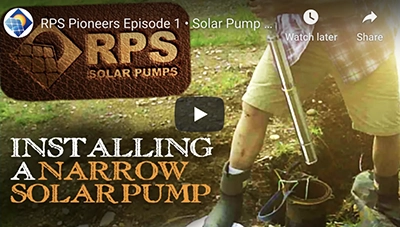Floating Pump in River to Pressure Tank for Sprinkler

Kick up the pressure! Without a pressure tank, solar pumps can easily provide up to 20 PSI for things like drip lines, flood irrigation or other micro irrigation. For 30, 45 or 60 PSI applications, like sprinklers (B) or soakers, you’ll need to pair a pressure tank (A) to maintain consistent flow. We have solar pumps that accommodate a single 5 GPM sprinkler, or higher volume options for a zone of multiple sprinklers 20+GPM.
Two pieces of special plumbing are needed to make a submersible pump to pressure tank system work; a check valve and a reverse action pressure switch. The check valve (B), a one way valve that stops water from draining back through the pump, helps maintain pressure in the pipeline. The reverse action pressure switch (A) senses changes in pipeline pressure, if the pressure tank is emptying and therefore asking for more water, or filled up. The reverse action pressure switch is wired into the charge controller and will send a sensor pulse to either turn on the pump (if the pressure tank is asking for water) or turn the pump off (if the pressure tank is full). When an irrigation timer (A) is added into the equation the pressure tank only starts discharging water once the ball bearing in the irrigation timer opens up the pipeline. Reverse action pressure switches are adjustable to a variety of settings like 40/60 , 30/50 or 20/40, we sell there here. Watch our video about adjusting a reverse action pressure switch here. If the water was allowed to drain back through the pump without the check valve (which is sometimes useful in freeze proofing a system) then the reverse action pressure switch would not be able to sense the changes in line pressure. And if you’re worried about the pump turning on/off multiple times during the day – don’t be! Our submersible pumps are all soft start/ slow stop, meaning no grinding parts or start up torque.


